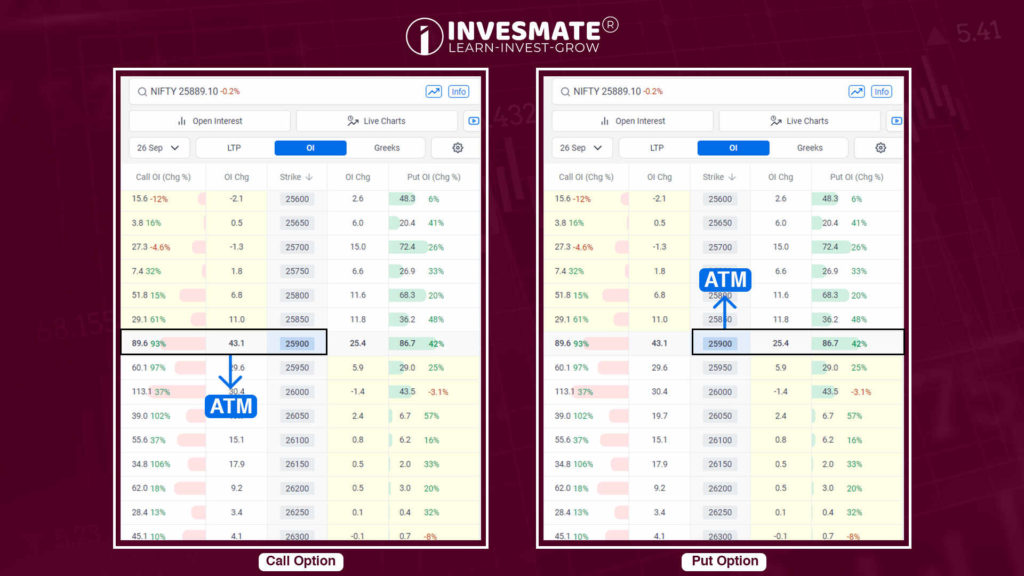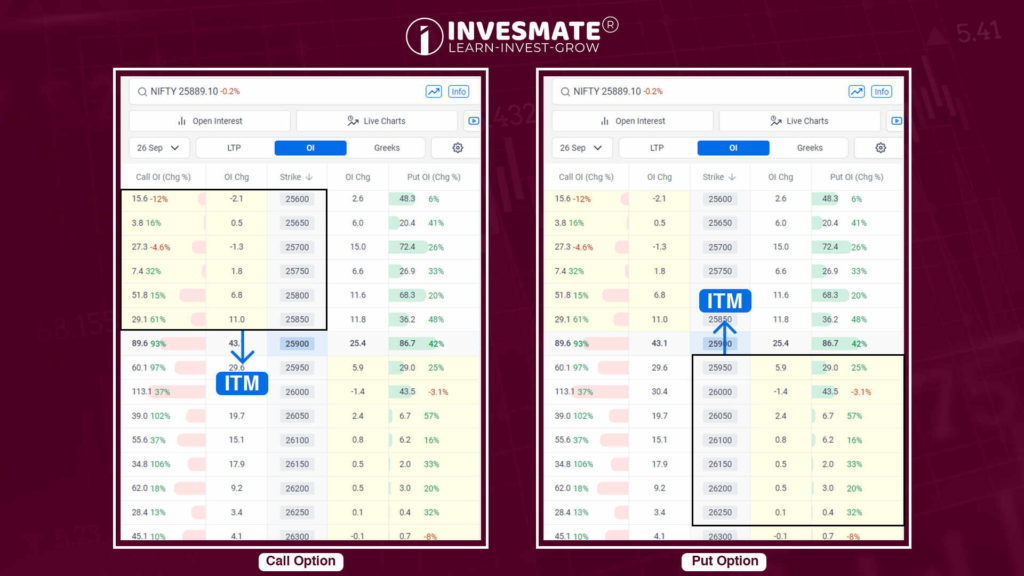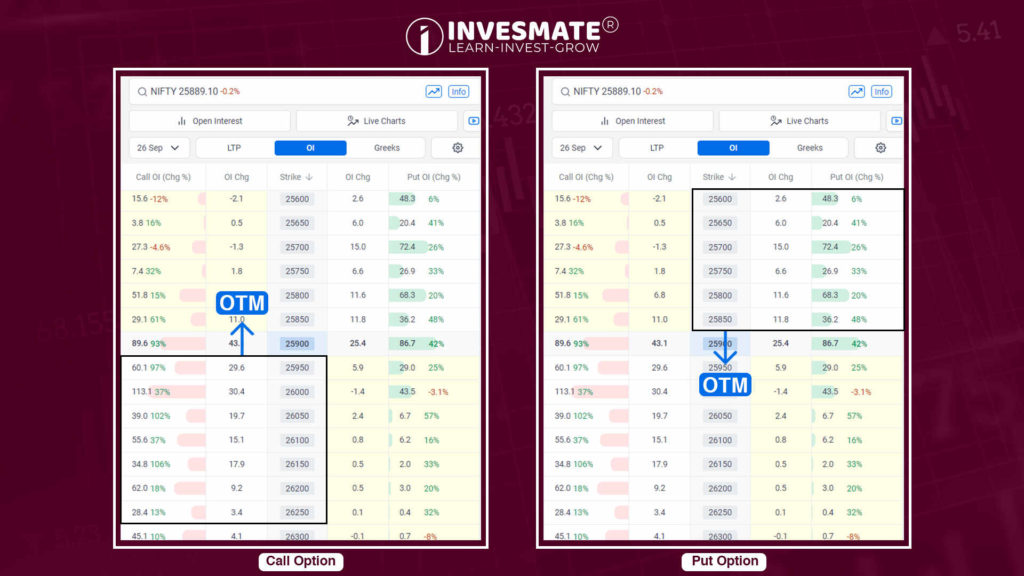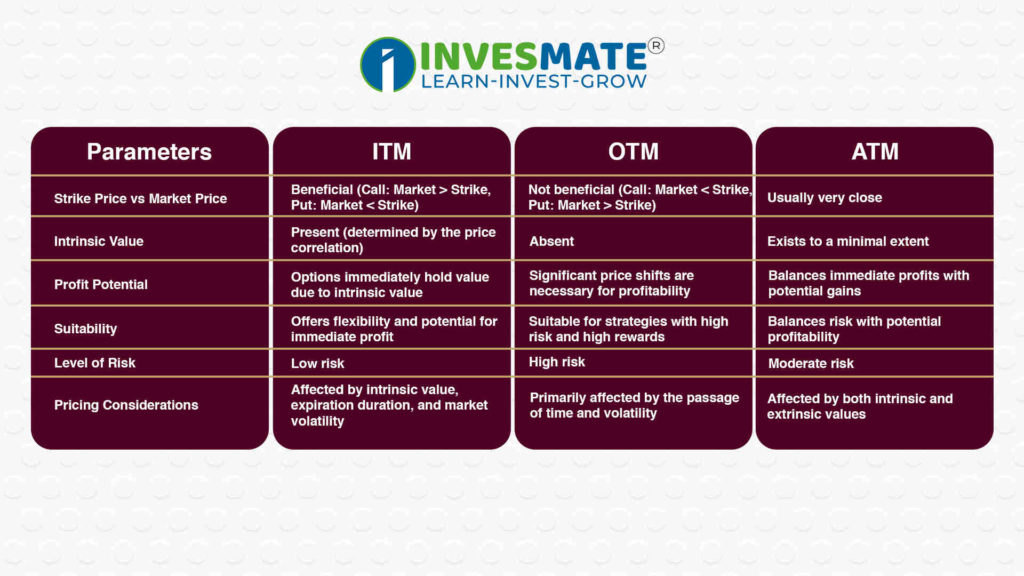In the Stock Market, Option Trading is an extremely important concept. Therefore, understanding its basic aspects is essential. We have already discussed some complex concepts of Option Trading in simple terms, such as:
- The Beginner’s Guide to Options Trading
- A beginners guide to call options trading
- A Beginner’s Guide to Understanding Put Options
- What is Options Premium – Definition, Calculation & Formula
You can read these blogs if you wish.
Just as these concepts are important in Option Trading, it is equally crucial to understand the concepts of ATM (At-The-Money), ITM (In-The-Money), and OTM (Out-Of-The-Money). These terms describe the relationship between the option’s strike price and the underlying asset price.
Through this blog, we will provide a key understanding of what ATM, ITM, and OTM are, and the differences between them, which will strengthen your trading journey.
What are ATM, ITM, and OTM?
ATM , ITM and OTM are terms used to describe the relationship between the strike price of an option and the current price of the underlying asset. Understanding these terms helps traders assess the value and risk of an option.
ATM :
The strike price of the option is equal to or very close to the current price of the underlying asset.
- This scenario occurs when the option has no intrinsic value.
ITM :
- The strike price of the option is favourable compared to the current price of the underlying asset.
- The way this favourable situation occurs varies between call options and put options.
- For a call option, if the underlying asset price is higher than the strike price, it is ITM.
- For a put option, if the underlying asset price is lower than the strike price, it is ITM.
**It is important to highlight that ITM options possess intrinsic value since they can be exercised for profit.
OTM :
The strike price of the option is not favourable compared to the current price of the underlying asset.
This undesirable situation unfolds differently under call options and put options.
For a call option, if the price of the underlying asset price is less than the strike price, it is OTM.
For a put option, if the price of the underlying asset is higher than the strike price, it is OTM.
Out-of-the-money options have no intrinsic value.
Example of ATM, ITM, and OTM
Imagine that the current price of the Nifty underlying asset is 25,889. Now, let’s analyze how these three scenarios occur in the options market when you decide to buy or sell a call and put option.
ATM ( At-The-Money)
Let’s say you decide to buy an At-The-Money (ATM) call option. In this case:
The strike price of the option will be ₹25,900.
On the other hand, you decide to buy an At-The-Money (ATM) Put option. In this case:
The strike price of the option will be ₹25,900.
In both cases, the ATM strike price equals the current market price of the underlying asset, indicating no difference between them.
Key Characteristics of ATM Options:
- Minimal Intrinsic Value: ATM options have little to no intrinsic value, making their pricing primarily based on extrinsic factors.
- Balanced Risk and Reward: They offer a middle ground, with potential for profit without the higher costs of ITM options.
- Potential for Volatility: The value of ATM options can fluctuate significantly with small price movements in the underlying asset.
ITM ( In-The-Money)
For Call Options, ITM means:
- The strike prices of 25,850, 25,800, 25,750, and 25,700 are considered ITM because they are below the current market price of the underlying asset.
For Put Options, ITM means:
- The strike prices of 25,950, 26,000, 26,050, and 26,100 are considered ITM because they are above the underlying asset price.
Key Characteristics of ITM Options:
- Higher Premiums: ITM options cost more due to their intrinsic value.
- Lower Risk: They are less risky than ATM or OTM options because they already have intrinsic value.
- Greater Likelihood of Exercise: ITM options are more likely to be exercised profitably before expiration.
OTM (Out Of The Money)
For Call Options, OTM means:
- The strike prices of 25,950, 26,000, 26,050, and 26,100 are considered OTM because they are above the current market price of the underlying asset.
For Put Options, OTM means:
- The strike prices of 25,850, 25,800, 25,750, and 25,700 are considered OTM because they are below the current price of the underlying asset.
Key Characteristics of OTM Options:
- Lower Premiums: OTM options are cheaper since they have no intrinsic value.
- Higher Risk, Higher Reward: They are riskier as they may expire worthless, but they offer higher potential returns due to their lower cost.
Why Traders Analyse ATM, ITM, and OTM?
Traders analyse the relationship between ATM (At-the-Money), ITM (In-the-Money), and OTM (Out-of-the-Money) options and their strike prices to gauge potential profitability. such as-
- Assessing Risk: Evaluating risk based on option type.
- Determining Profit Potential: Understanding intrinsic and extrinsic values for potential returns.
- Strategic Positioning: Aligning option choices with market outlooks.
- Market Sentiment: Analysing trading volume and open interest for insights into price movements.
Difference Between ITM, OTM, and ATM Options
Understanding the distinctions between ITM, ATM and OTM options is crucial for any options trader. Here’s a detailed comparison:
FAQs
It depends on your strategy. ITM options are safer but come at a higher price, while OTM options are riskier. However, if they move in your favour, they offer the potential for high rewards. ATM options lie somewhere in between.
If the price of the underlying asset moves in the option’s favour, the OTM option can turn into an ITM option.
Profitability depends on market conditions. ITM options offer immediate profit potential due to their intrinsic value, while OTM options can provide higher returns if the underlying asset moves significantly in their favour. However, OTM options are riskier.







Leave a Reply